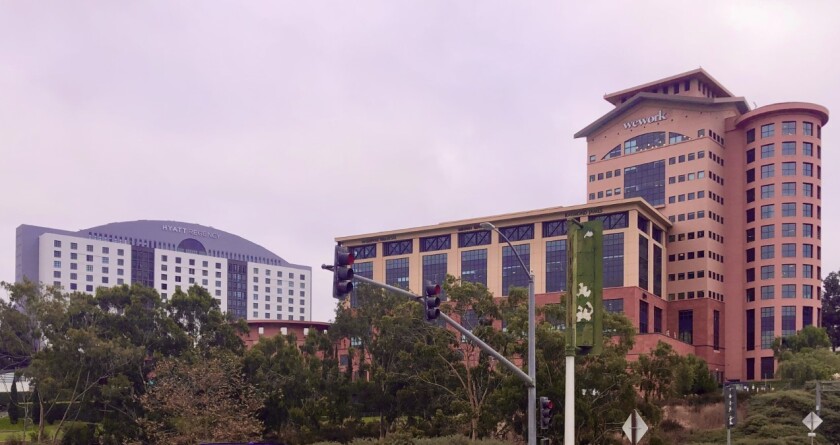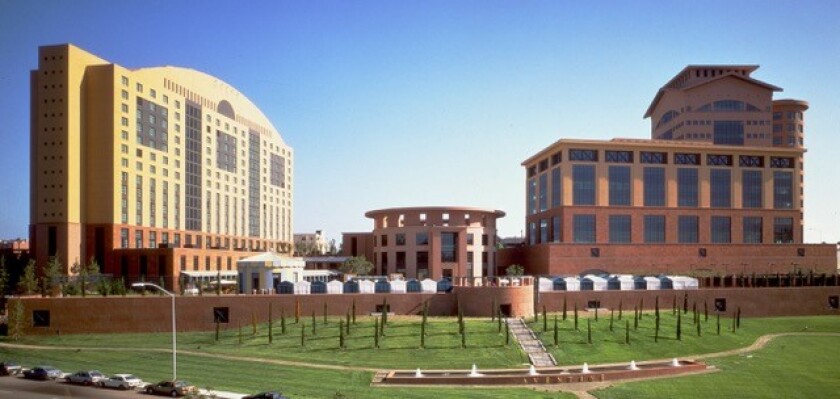When the Hyatt Regency La Jolla at Aventine opened more than three decades ago, it quickly became an iconic building anchoring the west end of the La Jolla Village Drive corridor between Interstates 5 and 805.
Its design incorporated symbolism of ancient Rome with its health spa rotunda, statuary, columns and extensive use of marble. Rome was erected on seven hills — one was named Aventine.
Developer Jack Naiman held a competition between two highly regarded architects, I. M. Pei and Michael Graves. He chose the design by Graves, a giant in the postmodern design movement and a professor of architecture at Princeton.
Every aspect of the building at 3777 La Jolla Village Drive, including its interior built-ins, furniture, light fixtures, wallpaper, fabrics and flooring, was designed by Graves.
The exterior paint, in earthy shades of terracotta and ochre, set a tone for future development in the community, according to Scott Pedersen, a jazz concert promoter and civil engineer by training who harbors a love of architecture.
He said the Aventine hotel, sporting club and office building complex influenced surrounding development, notably the Renaissance residential and retail space, the North University library and Illumina headquarters.
It also became a public event landmark as the site of a jazz festival for years and an annual “Times Square West” New Year’s Eve celebration that, when the millennium dawned, was broadcast live on CNN and Fox TV. “The Hyatt Aventine is not just a hotel — it is a location,” Pedersen said.
But the new color scheme of peppercorn gray and white, Pedersen maintains, takes the hotel from San Diego Architectural Foundation “Orchid” award winner in 1990 to “Onion” status.

To the right of the recently repainted Hyatt Regency La Jolla hotel is the rotunda, barely visible in the trees, and the office complex (now under separate ownership). Both show the original color scheme and are due to be repainted.
(Diane Bell)
“I believe Mr. Naiman and, specifically, Michael Graves would have never agreed to allow the current ‘white washing’ and removal of the iconic and stunning exterior treatments that went into this work of art,” Pedersen wrote in a recent note to city senior planner Katie Witherspoon.
It isn’t the paint job, per se, but the potential ramifications of the damage to a Graves building that bother Pedersen. He complimented the interior remodeling as looking “fresh and contemporary to meet the market demand. My only issue is the exterior.”
The 16-story hotel has had several owners. It and the former sporting club were sold last year to Hong Kong-based Gaw Capital, a private equity fund manager focused on real estate. Gaw has embarked on a $15 million renovation with the help of Hyatt, which manages the property. In their view, they are giving the property a much-overdue face-lift.
But do you update the Roman Colosseum? asks Pedersen. Do you repaint Mona Lisa’s smile?
“Over the last 30 years there really has been no change whatsoever to the outside of the building,” said hotel General Manager David Lockard. With all of Gaw’s reinvestment in the hotel’s meeting space and its redesign of the market, lobby and public spaces, it felt compelled “to match that on the outside of the building as well.”
“We felt the new look of the building, the paint scheme as well as new Hyatt Regency sign [at the top], helped indicate to the local community that this hotel is going through a rebirth,” he said.

The Hyatt Regency La Jolla in its original colors.
(Courtesy of Scott Pedersen)
With the exception of an anonymous email, Lockard said the reaction he has received has been overwhelmingly positive, particularly from repeat guests. “They enjoy the refreshed look of the building. It has had the same paint scheme for the last 30 years. It was nice to see a change.”
The second phase of interior remodeling started recently, with completion expected in early January. The repainting of the adjacent three-story rotunda building, which formerly housed the sporting club, is slated to begin this week.
The office buildings, once part of the original complex, are under different ownership, but Lockard said the owners plan to repaint the exteriors in similar shades of gray and white.
Steve Pelzer, who was the general manager when the hotel opened, said: “To me, it’s criminal that they would just take this significant architectural masterpiece and turn it into another gray and white, boutique, trendy chain hotel.”
Pelzer, who attended the Dec. 15, 1989, black-tie opening with Graves, said there was a plan underlying all of Graves’ designs. He believed everything sprang from the earth, hence, all the hotel rugs, even in the elevators, had floral designs, Pelzer said.
Pelzer said he didn’t add a public waste basket, planter boxes or the plants that went in them without consulting the architect.
While renowned for architectural achievements such as the Humana Building in Kentucky, the Portland Building in Oregon and two Disney hotels in Orlando, Fla., Graves is perhaps most known to the general public for his silver teapot with a red bird on its spout and other sleek kitchen appliance designs.
He died in 2015 at age 80, so he can’t respond to the current hotel color controversy. In 1986, Graves elaborated on the importance of color when he unveiled his design to San Diego at the Museum of Contemporary Art in La Jolla. In a news report, he described the deep terracotta tone of Spanish quartzite at the base moving upward in successively lighter ochre colors of stucco.
“The character derived from these materials will most certainly give a sense of substance and permanence to the buildings, which should provide timeless meaning,” Graves said. ◆
"hotel" - Google News
October 25, 2020 at 10:02PM
https://ift.tt/3dXvouG
Iconic Hyatt Regency La Jolla hotel gets a trendy new look - La Jolla Light
"hotel" - Google News
https://ift.tt/3aTFdGH
https://ift.tt/2xwvOre
Bagikan Berita Ini














0 Response to "Iconic Hyatt Regency La Jolla hotel gets a trendy new look - La Jolla Light"
Post a Comment